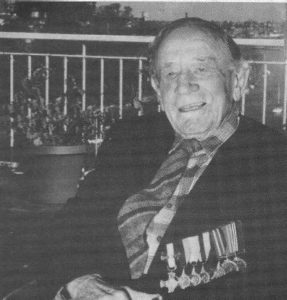- Author
- Cleary, Brian, Commodore, RAN (Rtd)
- Subjects
- Biographies and personal histories, History - WW2, Obituaries
- Tags
-
- RAN Ships
- HMAS Bataan, HMAS Canberra I, HMAS Australia II
- Publication
- March 1996 edition of the Naval Historical Review (all rights reserved)
Arthur Stanley Storey was 13 years old when selected to enter the Royal Australian Naval College in 1923 as one of 12 Cadet Midshipmen. His peers were quick to note that his initials provided a ready foundation for the nickname “Donk”. It was an early measure of the man to be that he happily adopted the pseudonym for use in all company for the rest of his life.
His academic, sporting and professional achievements at the Naval College were outstanding and included the award of the King’s Medal for gentlemanly bearing, character, good influence among his fellows and officer like qualities. After graduation in 1926 he proceeded to the United Kingdom for further shore and sea training as Midshipman and Sub-Lieutenant.
He returned to Australia at the end of 1930 to serve in the heavy cruiser HMAS Australia as a Lieutenant. In mid 1934 he was back in England for training as a Gunnery specialist. The period 1937-1938 saw him serving in HMA Ships Canberra and Australia.
With the threat of war with Germany looming in 1939 he was sent to the United Kingdom to help man the growing Royal Navy. Shortly after the outbreak of war he was appointed to the new light cruiser, HMS Naiad as Gunnery Officer in the rank of Lieutenant-Commander. After service in the Atlantic and the Arctic the Naiad was sent to reinforce the Mediterranean Fleet on Italy’s entry into the war in mid 1940. There she became flagship of the 15th Cruiser Squadron wearing the flag of Rear Admiral Philip Vian with Donk as Squadron Gunnery Officer.
By the end of 1941, following many naval actions and losses, the 15th Cruiser Squadron of 3 light cruisers was the major surface fighting force left in the Eastern Mediterranean. In December 1941 the Squadron and its escort of 6 destroyers fought a supply convoy through to Malta in the face of constant daylight air attack and attempted intervention by an Italian force of 3 battleships, 3 heavy cruisers and escorting destroyers. An attempt to reinforce the Squadron with HMS Cleopatra in March 1942 resulted in the successful arrival of the Cleopatra but the sinking of the Naiad by German submarine.
Taking Donk with him, the Admiral transferred his flag to Cleopatra. Within a week the Squadron and 11 destroyers were off again in support of another convoy to Malta. In addition to constant daylight air attack the force beat off a determined attack by an Italian surface force of a battleship, 3 cruisers and 10 destroyers. Admiral Lord Cunningham later described this action as “one of the most brilliant Naval actions of the War, if not the most brilliant.”
For his part Donk was awarded a bar to the Distinguished Service Cross awarded for his services in HMS Naiad.
After 3 years constant sea service he returned to Australia where he spent 18 months shore service in the rank of Commander. In mid 1944 he was appointed to HMAS Australia on the staff of the Commodore Commanding the Australian Squadron. During actions off Leyte and Lingayen in the Philippines Donk survived six Kamikaze attacks.

In March 1945, at the special request of Vice Admiral Sir Phillip Vian, commanding the 1st Aircraft Carrier Squadron of the British Pacific Fleet, Donk joined HMS Indomitable as a member of the Admiral’s operations staff. Here, during air operations against the Japanese home islands, Donk experienced 2 further Kamikaze attacks and, after transferring with the flag to HMS Formidable, his 9th attack. As soon as the war ended Donk was recalled to take up duty as Executive Officer in HMAS Australia. Before taking up his posting his appointment was changed to Director of Naval Intelligence in Melbourne. After 2 1/2 years ashore he was posted to the command of the destroyer HMAS Bataan.
In April 1949 Donk resigned his commission, an event which shocked his peers and all who knew him, particularly as his promotion to Captain in June 1949 was expected with confidence. Throughout his 26 years of Naval Service his performance could be regarded only as exemplary. His official service record is a never ending list of superlatives when describing him. It was, perhaps, significant that after leaving the Naval College he spent a mere 4 years shore service in Australia.




